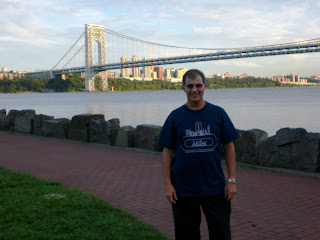Fort Lee Historic Park, Bergen County, NJ





On an August 31, 2009 late in the day Memorial Miler Paul Pietropaolo stopped by the Fort Lee Historic Park and the New Jersey Section of the Palisades Interstate Park in Bergen County to check out the view of the George Washington Bridge and explore this section of the park. While on the shore of the Hudson River, I could see the famous “Little Red Lighthouse” under the George Washington Bridge on the Manhattan side. It is amazing to realize all the history and natural beauty of the area; I have seen a lot of very wonderful things on my Memorial Mile walks and runs!
Palisades Interstate Park New Jersey Section
Located in northeastern Bergen County, New Jersey, a beautiful park that is part of the more than 100,000 acres of parkland's and historic sites managed by the Palisades Interstate Park Commission. The land in the NJ Section was the first that the Commission acquired after its creation in 1900 by the states of New York and New Jersey. The Commission had been formed to prevent the defacement of the famous Palisades of the Hudson by a handful of large stone quarries then in operation.
The NJ Section about 12 miles long and half-a-mile wide at its widest, with 2,500 acres of wild Hudson River shore front and uplands, including some of the most impressive sections of the Palisades.
The Palisades have been designated a National Natural Landmark, the Palisades Interstate Park a National Historic Landmark. Both the Long Path and the Shore Trail have been designated National Recreation Trails.
Fort Lee Historic Park
Fort Lee Historic Park is set on 33 landscaped acres atop the Palisades just south of the George Washington Bridge, with spectacular overlooks of the Hudson, Manhattan, and the George Washington Bridge. There is a Visitor Center and Museum, reconstructed 18th Century soldier hut and campsite, and reconstructed gun batteries.
Fort Lee Historic Park's significance came about during the 1776 British campaign to control New York City and the Hudson River. In July of 1776, work was begun on this site, which was eventually named for General Charles Lee, who aided in the defense of New York City. On the opposite New York shore, work had already begun on Fort Washington.On July 12, Admiral Richard Howe sent two British naval vessels up the Hudson River. Cannon fire from Fort Washington had little effect on their passage. Washington then ordered that work on Fort Lee continue as quickly possible.
On August 22, the British landed on Long Island and five days later forced the Americans to retreat to New York City. Through September and October, the British and American forces were involved in battles at New York City, Harlem Heights, and White Plains. The British then turned their forces against Fort Washington.
On November 16, Fort Washington fell to an overwhelming assault by the British forces, which captured over 2,000 American troops.General Washington, realizing that with the loss of Fort Washington, that Fort Lee was of little military value, made preparations to evacuate his remaining army through New Jersey.
On November 20, General Cornwallis ferried about 5,000 men across the Hudson north of Fort Lee. When word reached Washington, he ordered an immediate retreat before his army was cut off and captured by the British.
Most of the American supplies and artillery had to be left behind. These were indeed the darkest days for the Revolution and led to Thomas Paine's famous words, "These are the times that try men's souls…"
Fort Lee has been named as a significant stop on the Hudson River Valley National Heritage Area Revolutionary War trail.
The Little Red Lighthouse:
Located in Fort Washington Park, 178th Street and the Hudson River, is Manhattan’s only remaining lighthouse acquired its affectionate nickname from Hildegarde H. Swift’s 1942 children’s classic, The Little Red Lighthouse and the Great Gray Bridge.
Illustrated by Lynd Ward, this tale of the friendship between the tiny beacon and the George Washington Bridge introduced children around the world to the red, round, and very, very proud little lighthouse in New York.
Built in 1880, the 40-foot tower was moved in 1921 to Jeffrey’s Hook, a rocky point on the Hudson River near Manhattan’s northern edge. The Lighthouse warned ships away from the shore as they made their way down the narrow channel between New York and New Jersey.
However, when construction of the George Washington Bridge was completed in 1931, the brilliant lights of the bridge’s 600-foot towers overwhelmed the little Lighthouse. In 1947, it was officially decommissioned and abandoned, and by 1951, the Little Red Lighthouse was slated for demolition – its cast-iron shell to be sold for scrap.
Hearing this news, thousands of children who had loved Swift’s book started a nationwide campaign to save the Little Red Lighthouse. Thanks in part to their efforts; ownership of the Lighthouse was transferred from the Port Authority of New York and New Jersey to the New York City Department of Parks & Recreation.
The Little Red Lighthouse:
Located in Fort Washington Park, 178th Street and the Hudson River, is Manhattan’s only remaining lighthouse acquired its affectionate nickname from Hildegarde H. Swift’s 1942 children’s classic, The Little Red Lighthouse and the Great Gray Bridge.
Illustrated by Lynd Ward, this tale of the friendship between the tiny beacon and the George Washington Bridge introduced children around the world to the red, round, and very, very proud little lighthouse in New York.
Built in 1880, the 40-foot tower was moved in 1921 to Jeffrey’s Hook, a rocky point on the Hudson River near Manhattan’s northern edge. The Lighthouse warned ships away from the shore as they made their way down the narrow channel between New York and New Jersey.
However, when construction of the George Washington Bridge was completed in 1931, the brilliant lights of the bridge’s 600-foot towers overwhelmed the little Lighthouse. In 1947, it was officially decommissioned and abandoned, and by 1951, the Little Red Lighthouse was slated for demolition – its cast-iron shell to be sold for scrap.
Hearing this news, thousands of children who had loved Swift’s book started a nationwide campaign to save the Little Red Lighthouse. Thanks in part to their efforts; ownership of the Lighthouse was transferred from the Port Authority of New York and New Jersey to the New York City Department of Parks & Recreation.
Today, visitors climb a long, iron stair to the top of the tower, where the lantern room is again fitted with a working lens that blinks proudly at cargo barges and passenger ships sailing under the George Washington Bridge.
The Little Red Lighthouse is owned by the New York City Department of Parks & Recreation and is a member of the Historic House Trust and is located in Fort Washington Park, 178th Street and the Hudson River, Manhattan. The lighthouse is open on a regular basis for tours from Spring thru Fall, led by Urban Park Rangers. Call ahead for schedule and information. Inside the lighthouse are historical exhibits on the lighthouse and area.
To reach the lighthouse, located in Fort Washington Park, drive your car or take the "A" train to West 181 Street. Walk west on 181 St, down the hill toward the Hudson River, cross the pedestrian foot bridge just north of 181 St. and follow the winding path into the park and the lighthouse.
The Little Red Lighthouse stopped being used as a functional lighthouse long ago, but over the years, this 40-foot-high structure has become a beacon of another kind.Located underneath the George Washington Bridge along a treacherous section of the Hudson River once known as Jeffrey’s Hook, this is one of the few surviving lighthouses in New York City and serves as a quaint reminder of the area’s history.
Long ago, Native Americans known locally as the Wiechquaesgeck-part of the Lenape tribe inhabited much of the upper Manhattan and eastern New Jersey. The Wiechquaesgeck, and later the Dutch and English colonists, fished and hunted along the banks of the Hudson River.
The Hudson was also an important route for travel, connecting upstate cities such as Albany to New York City and the Atlantic Ocean. As traffic increased along the river, so did the number of shipwrecks at Jeffrey’s Hook. In an attempt to reduce accidents, a red pole was placed at Jeffrey’s Hook jutting out over the river to warn travelers of danger.
In 1889, two 10-candlepower lanterns were placed on the pole to aid navigation. Much of the land surrounding the lighthouse, including the riverbanks of Jeffrey’s Hook, was acquired by the City in 1896, and became known as Fort Washington Park.In the early 20th century, barge captains carrying goods up and down the Hudson demanded a brighter beacon.
The Little Red Lighthouse had originally been erected on Sandy Hook, New Jersey in 1880, where it used a 1,000 pound fog signal and flashing red light to guide ships through the night. It became obsolete and was dismantled in 1917. In 1921, the lighthouse was reconstructed on Jeffrey’s Hook in an attempt to improve navigational aids on the Hudson River.
Run by a part-time keeper and furnished with a battery-powered lamp and a fog bell, the lighthouse, then known as Jeffrey’s Hook Lighthouse, was an important guide to river travelers for ten years. The George Washington Bridge opened in 1931, and the brighter lights of the bridge again made the lighthouse obsolete.
In 1948, the Coast Guard decommissioned the lighthouse, and its lamp was extinguished.The Coast Guard planned to auction off the lighthouse, but an outpouring of support for the beacon helped save it. The outcry from the public was prompted by the children’s book The Little Red Lighthouse and the Great Gray Bridge, written by Hildegarde Swift, illustrated by Lynd Ward and published in 1942.
In the popular book, the Little Red Lighthouse is happy and content until a great bridge is built over it. In the end, the lighthouse learns that it still has an important job to do and that there is still a place in the world for on old lighthouse. The classic tale captured the imaginations of children and adults, many of whom wrote letters and sent money to help save the icon from the auction block.
On July 23, 1951, the Coast Guard gave the property to the City of New York, and on May 29, 1979, the Little Red Lighthouse was added to the National Register of Historic Places.

